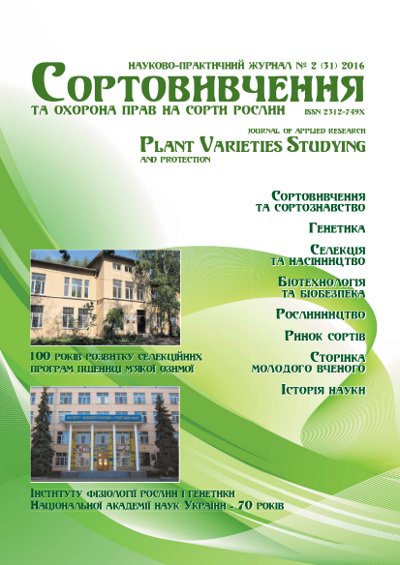Breeding of hexaploid triticale for drought resistance
DOI:
https://doi.org/10.21498/2518-1017.2(31).2016.70252Keywords:
hexaploid triticale, interspecific hybridization, multiline varieties, drought resistanceAbstract
Purpose. Analysis of hexaploid triticale breeding process for drought resistance through the use of systemic ecological tests in contrasting conditions. Methods. Dialectical, field, laboratory and statistical ones. Results. Medium-grown (‘Amos’, ‘Nikanor’, ‘Rarytet’, ‘Yaroslava’) and low-stem (‘HAD 69’, ‘HAD 86’, ‘HAD 110’, ‘Timofei’) multiline varieties of winter and alternate hexaploid triticale were developed with higher adaptability, potential yield of 9–12 tons per ha and high bread-making properties. Among the most drought resistant genotypes, such varieties as ‘Amos’, ‘Buket’, ‘Harne’, ‘Markiian’, ‘Kharroza’, ‘Shalanda’, ‘Nicanor’ and ‘Yaroslava’ showed high values of yield, plasticity and stability. Conclusions. The use of interspecific hybridization instead of intergeneric one in hexaploid triticale breeding, together with systemic testing of the hybrid material in contrasting agro-ecological zones, ensured the creation of multiline competitive varieties with an optimal combination of yield and adaptive properties
Downloads
References
Grabovets, A. I. (2010). Metody i rezul’taty selektsii ozimogo tritikale na Donu [Methods and results of breeding winter triticale at the Don region]. In Tritikale. Genetika, selektsiya, agrotekhnika, ispol‘zovanie zerna i kormov: mater. Mezhd. nauchno-prakt. konf. [Triticale. Genetics, breeding, agricultural machinery, the use of grains and feed: Proceedings of the International Scientific and Practical Conference]. (Vol. 4, pp. 66–74). Rostov-on-Don, Russia. [in Russian]
Marciniak A., Obuchowski W., & Makowska, A. (2008). Technological and nutritional aspects of utilization of triticale for extruded food production. Electronic Journal of Polish Agricultural Universities, 11(4). Retrieved from http://www.ejpau.media.pl/volume11/issue4/art-04.html
CIMMYT Int. (2014). CIMMYT Annual Report 2013: Agricultural Research for Development to Improve Food and Nutritional Security. Mexico, DF: CIMMYT Int.
Khangil’din, V. V. (1978). O printsipakh modelirovaniya sortov intensivnogo tipa [On principles of modeling intensive type varieties]. In Genetika kolichestvennykh priznakov sel’skokhozyaystvennykh rasteniy [Genetics of quantitative traits of agricultural plants]. (pp. 111–116). Moscow: Nauka. [in Russian]
Eberhart, S. A., & Russell, W. A. (1966). Stability Parameters for Comparing Varieties. Crop Sci., 6(1), 36–40.
Pakudin, V. Z., & Lopatina, L. M. (1984). Otsenka ekologicheskoy plastichnosti i stabil’nosti sortov sel’skokhozyaystvennykh kul’tur [Assessment of the ecological plasticity and stability of agricultural crops varieties]. Sel’skokhozyaistvennaya biologiya [Agricultural Вiology], 40, 109–113. [in Russian]
Dospekhov, B. A. (1985). Metodika polevogo opyta (s osnovami statisticheskoy obrabotki rezul’tatov issledovaniy) [Methods of field experiment (with the basics of statistical processing of research results)]. (5nd ed., rev.). Moscow: Agropromizdat. [in Russian]
Shchipak, G. V. (1994). O selektsii ozimykh geksaploidnykh tritikale na adaptivnost’ k neblagopriyatnym faktoram sredy [On selection of winter hexaploid triticale for adaptability to adverse environmental factors]. Sel’skokhozyaistvennaya biologiya [Agricultural Вiology], 5, 38–42. [in Russian]
Shchipak, G. V., Suvorova, E. Yu, Shchypak, P. V., Shchipak, V. G., Sotnikov, D. A., & Grin›, V. O. (2008). Vklad selektsii v izmenenie ozimykh geksaploidnykh tritikale [Contribution of breeding to the change in winter hexaploid triticale]. Faktory eksperymentalnoi evoliutsii orhanizmiv [Factors in Experimental Evolution of Organisms], 5, 191–195. [in Russian]
Shchipak, G. V., Shchipak, V. G., Matviets, V. G., Plaksa, V. N. (2014). Selektsiya geksaploidnykh tritikale na uluchshenie vypolnennosti zerna [Hexaploid triticale breeding for improving the grain fillness]. Visnyk centru naukovogo zabezpechennja APV Harkivs’koi’ oblasti [Bulletin of Center for Science Provision of Agribusiness in the Kharkiv region], 16, 257–272. [in Russian]
Downloads
Published
How to Cite
Issue
Section
License
Copyright (c) 2016 Ukrainian Institute for Plant Variety Examination

This work is licensed under a Creative Commons Attribution-ShareAlike 4.0 International License.
Starting in 2022, the copyright to the publication remains with the authors
Our journal abides by the CREATIVE COMMONS copyright rights and permissions for open access journals.
Authors, who are published in this journal, agree to the following conditions:
- The authors reserve the right to authorship of the work and pass the first publication right of this work to the journal under the terms of a Creative Commons Attribution License, which allows others to freely distribute the published research with the obligatory reference to the authors of the original work and the first publication of the work in this journal.
- The authors have the right to conclude separate supplement agreements that relate to non-exclusive work distribution in the form in which it has been published by the journal (for example, to upload the work to the online storage of the journal or publish it as part of a monograph), provided that the reference to the first publication of the work in this journal is included.

























 Ukrainian Institute for Plant Varieties Examination
Ukrainian Institute for Plant Varieties Examination  Селекційно-генетичний інститут
Селекційно-генетичний інститут Institute of Plant Physiology and Genetics of the National Academy of Sciences of Ukraine
Institute of Plant Physiology and Genetics of the National Academy of Sciences of Ukraine
 The National Academy of Agrarian Sciences of Ukraine
The National Academy of Agrarian Sciences of Ukraine